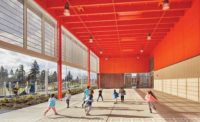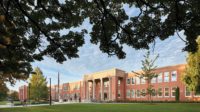Not many land uses are as unwelcome near an urban residential neighborhood as a dump. Calling it a solid waste transfer station implies a certain seriousness of purpose, even respectability, but there’s no getting away from the fact that this is where garbage trucks dump their loads, self-haulers line up to chuck old mattresses and yard waste, and semis growl in to shuttle the stuff away.
Chances of getting locals to accept a new waste transfer facility in their backyard? Slim to none. Unless, that is, the neighborhood grew up on the edge of an industrial zone where a transfer station already existed, as did Seattle’s Wallingford and Fremont sections—two neighborhoods that overlook active Lake Union and its ship canal, with Seattle’s skyline beyond, and abut the North Transfer Station (NTS). For Wallingford-Fremont, a new transfer station is an improvement.
Additional Content:
Jump to credits & specifications
Compared to the smaller, late 1960s pit facility it replaces, the new flat-floor NTS operates more safely and efficiently. Conditions of the community’s acceptance required the design to provide significant public amenities and to address community priorities, including sustainability, security, and aesthetics. “These constraints actually helped us,” says Anne Schopf, a partner at Mahlum, architect for the LEED Gold–certified project. Instead of having to advocate for community-sensitive urban design, “we were able to spend that energy innovating and making a better project.”
Bermed into a sloping 5½-acre site between the lake’s increasingly recreational waterfront to the south, residential development to the north and east, and a mix of uses to the west, the facility consists of two low-slung buildings on either side of a weigh-scale yard. The main structure comprises a 57,000-square-foot tipping and transfer floor, an administrative block, and a lower level for compacting and collection. The recycling building allows self-haulers to divert materials from the waste stream, a functionality the older facility lacked. The challenge of integrating large-scale infrastructure into a dense but low-rise neighborhood is what attracted Mahlum to the project, and the mediation of the industrial and human scales is its major achievement.
Horizontal massing is the first of two key strategies in this success. The massing responds to one of the community’s most stringent constraints: a building height limit of 78 feet above sea level—the same as the existing grade level at the site’s top corner. The limit enables the hillside neighborhood to literally overlook the facility’s presence and enjoy its lake and city views. In support, NTS rooftops are clear of mechanical equipment, and sport photovoltaic arrays and greenery instead.
However, even with the building partially embedded in the site’s 44-foot slope, keeping two levels of industrial-scale program under the limit took some ingenuity. To lower the main building’s already flat roof, its tri-chorded steel trusses rely on an innovative steel specification that allows a clear span of 200 feet using less depth than trusses built of more standard structural tubing. Skylights atop the 6-foot-wide trusses highlight the structure and admit daylight to the tipping and transfer floor below.
The second key tactic the project relies on is a more refined material expression than is typical for the building type. Cladding materials used with dump-defying effect include the administrative block’s expanses of glass, signaling the entrance and overlooking the scale yard. Translucent polycarbonate panels present a serene face to the lakefront and provide daylight to the tipping and transfer floor, while less prominent elevations are clad in precast concrete panels with a Mahlum-designed vertical pattern. Along the south facade, which fronts onto Seattle’s popular Burke-Gillman Trail, a site-cast concrete wall is sectioned, textured, fenestrated, and furnished to generate a human-scale street edge for the monumental volumes behind.
Along the site’s north and east edges, a retaining wall of architectural concrete screens the station’s workings and provides a textured backdrop to the tree-lined walks and play and exercise areas that meet the adjacent community. On its business side, the retaining wall drops to the transfer station’s forecourt, where its height and mass contain much of the noise that would otherwise escape into the neighborhood. Helping that effort, standing-seam black metal cladding angles out from the wall’s upper half, reflecting sound back down into the site. Visually, this partial cladding serves to reduce the wall’s scale and links to the buildings in the yard.
Operations manager Lee Momon reports that staff members are so pleased with their new workspace that they show up early for the job. Neighborhood parents and child-minders bring their kids to enjoy the new park and to watch the choreography on the tipping floor from an upstairs viewing room. The NTS has proven a hit with school groups too.
During the city’s design review process, at least one critic argued that the facility should “look more like a transfer station.” As cities continue to grow, however, and infrastructure once relegated to the margins is increasingly accommodated in evolving, mixed-use neighborhoods, Seattle’s North Transfer Station provides a valuable example for what this building type can be. With good design, even a dump makes a good neighbor.
CreditsArchitect: Mahlum — Mark Cork, principal in charge; Anne Schopf, design principal; Pierce McVey, project designer; Duncan Davidson, project manager; Luke Pulliam, project architect
Prime Consulting Engineer: CDM Smith
Consultants: Parametrix, LPD Engineering (civil); Integrated Design Engineers, CDM Smith (structural, hazmat); Greenbusch Group (m/p,acoustics); Triunity Engineering & Management (electrical); HBB Landscape Architecture (landscape); Gordon Environmental (solid waste)
General contractor: Lydig Construction
Client: Seattle Public Utilities |
SpecificationsSteel Fabricator Fought & Company
Exterior Metal Panels AEP Span
Glazing CPI Uniquad, Vitro Architectural Glass, Kalwall
Metal Frame Windows Kawneer
Green Roof Versico, Columbia Green Technologies |












Post a comment to this article
Report Abusive Comment